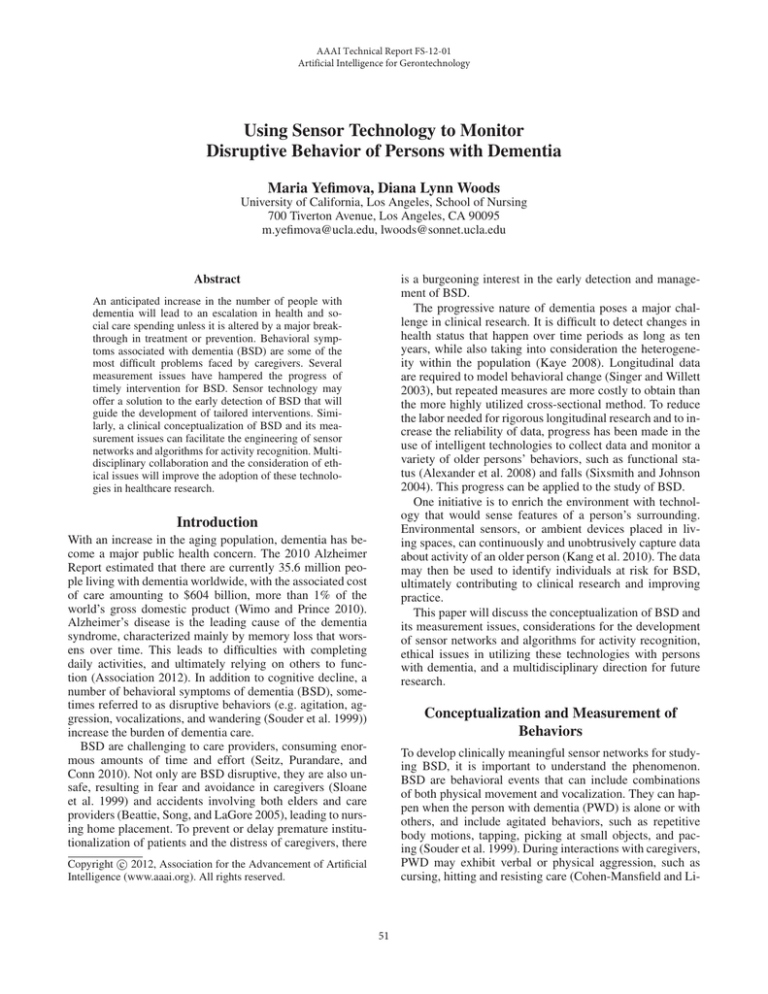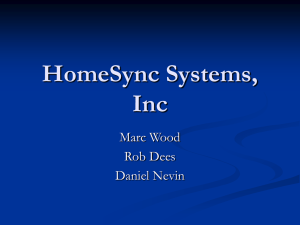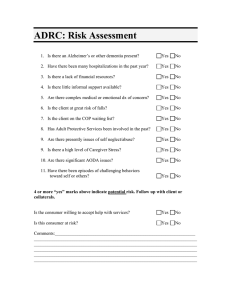Using Sensor Technology to Monitor Disruptive Behavior of Persons with Dementia
advertisement

AAAI Technical Report FS-12-01 Artificial Intelligence for Gerontechnology Using Sensor Technology to Monitor Disruptive Behavior of Persons with Dementia Maria Yefimova, Diana Lynn Woods University of California, Los Angeles, School of Nursing 700 Tiverton Avenue, Los Angeles, CA 90095 m.yefimova@ucla.edu, lwoods@sonnet.ucla.edu Abstract is a burgeoning interest in the early detection and management of BSD. The progressive nature of dementia poses a major challenge in clinical research. It is difficult to detect changes in health status that happen over time periods as long as ten years, while also taking into consideration the heterogeneity within the population (Kaye 2008). Longitudinal data are required to model behavioral change (Singer and Willett 2003), but repeated measures are more costly to obtain than the more highly utilized cross-sectional method. To reduce the labor needed for rigorous longitudinal research and to increase the reliability of data, progress has been made in the use of intelligent technologies to collect data and monitor a variety of older persons’ behaviors, such as functional status (Alexander et al. 2008) and falls (Sixsmith and Johnson 2004). This progress can be applied to the study of BSD. One initiative is to enrich the environment with technology that would sense features of a person’s surrounding. Environmental sensors, or ambient devices placed in living spaces, can continuously and unobtrusively capture data about activity of an older person (Kang et al. 2010). The data may then be used to identify individuals at risk for BSD, ultimately contributing to clinical research and improving practice. This paper will discuss the conceptualization of BSD and its measurement issues, considerations for the development of sensor networks and algorithms for activity recognition, ethical issues in utilizing these technologies with persons with dementia, and a multidisciplinary direction for future research. An anticipated increase in the number of people with dementia will lead to an escalation in health and social care spending unless it is altered by a major breakthrough in treatment or prevention. Behavioral symptoms associated with dementia (BSD) are some of the most difficult problems faced by caregivers. Several measurement issues have hampered the progress of timely intervention for BSD. Sensor technology may offer a solution to the early detection of BSD that will guide the development of tailored interventions. Similarly, a clinical conceptualization of BSD and its measurement issues can facilitate the engineering of sensor networks and algorithms for activity recognition. Multidisciplinary collaboration and the consideration of ethical issues will improve the adoption of these technologies in healthcare research. Introduction With an increase in the aging population, dementia has become a major public health concern. The 2010 Alzheimer Report estimated that there are currently 35.6 million people living with dementia worldwide, with the associated cost of care amounting to $604 billion, more than 1% of the world’s gross domestic product (Wimo and Prince 2010). Alzheimer’s disease is the leading cause of the dementia syndrome, characterized mainly by memory loss that worsens over time. This leads to difficulties with completing daily activities, and ultimately relying on others to function (Association 2012). In addition to cognitive decline, a number of behavioral symptoms of dementia (BSD), sometimes referred to as disruptive behaviors (e.g. agitation, aggression, vocalizations, and wandering (Souder et al. 1999)) increase the burden of dementia care. BSD are challenging to care providers, consuming enormous amounts of time and effort (Seitz, Purandare, and Conn 2010). Not only are BSD disruptive, they are also unsafe, resulting in fear and avoidance in caregivers (Sloane et al. 1999) and accidents involving both elders and care providers (Beattie, Song, and LaGore 2005), leading to nursing home placement. To prevent or delay premature institutionalization of patients and the distress of caregivers, there Conceptualization and Measurement of Behaviors To develop clinically meaningful sensor networks for studying BSD, it is important to understand the phenomenon. BSD are behavioral events that can include combinations of both physical movement and vocalization. They can happen when the person with dementia (PWD) is alone or with others, and include agitated behaviors, such as repetitive body motions, tapping, picking at small objects, and pacing (Souder et al. 1999). During interactions with caregivers, PWD may exhibit verbal or physical aggression, such as cursing, hitting and resisting care (Cohen-Mansfield and Li- c 2012, Association for the Advancement of Artificial Copyright Intelligence (www.aaai.org). All rights reserved. 51 bin 2005). Sleep disturbances and behaviors such as apathy and withdrawal are another manifestation of BSD. Occurrences of BSD vary considerably within and between individuals (Algase et al. 2010), which complicates their characterization. Further complicating matters, rather than being single events, BSD are clusters of various disruptive behaviors that may occur repeatedly in the same individual (Woods, Rapp, and Beck 2004). These clusters can escalate over time, becoming more troublesome, frequent and variable (Woods, Rapp, and Beck 2004). For example, a person may begin by mumbling incoherently and banging on a table, then pause before continuing into screaming and hitting the caregiver. Understanding the relationships between these clusters of behaviors may reveal the best timing for interventions to reduce burden of care for BSD. The characterization of BSD clusters is severely hampered by measurement and analysis issues. There are a number of clinical tools that measure behavior through direct observation; however, few consider the intensity of behaviors, rather noting only their presence or absence (Cummings 1996). A lack of information on the intensity of behaviors limits the discovery of escalation patterns. Additionally, the analysis of aggregated data, generally using the mean score, limits the identification of individual’s behavior patterns and variability. Some suggest that measuring individual variability may be the key to the timing of interventions and their success (Donaldson 2012). Therefore, new measurement and analysis strategies are necessary to effectively evaluate and improve research on BSD. Keeping in mind the challenges of identifying BSD clusters, the heterogeneity of behavior presentation, and the importance of focusing on individual’s variability, it is important to develop optimized sensor networks that can solve these issues. multi-modal sensor networks may be necessary. A study examined the feasibility of such system to detect agitation of a person in a lab setting. The recognition rate improved from 59%, using ultrasonic sensors alone, to 73%, with additional pressure sensors, and up to 94% in a multimodal sensor fusion (Biswas, Jayachandran, and Thang 2006). This has potential to be used with PWD in a clinical setting. Data from various sensors can be more accurate and insightful for behavior identification, but requires a more sophisticated network and processing capabilities. Table 1: Possible Sensors to Capture BSD Sensor Motion/ Radar/ GPS tracking Acoustic Pressure (bed) Video Behavior Restlessness Tapping/Banging Wandering Vocalization Sleep disturbances Daily Activities The technical requirements of sensor implementations need to be taken into consideration as well. Some research groups use wearable sensors, such as actigraphs and accelerometers (Kang et al. 2010). While they easily track individual actions, on-body devices can be discomforting for PWD and may result in unintentional loss or damage (Kang et al. 2010). On the other hand, sensors placed in the environment are unobtrusive and hence more acceptable with this population. Static positioning of ambient sensors requires deliberation (Suzuki et al. 2007). Some behaviors may only be exhibited in certain areas of the house, such as agitation during bathing. Power consumption and battery life are important for wireless sensors, while cable management is a burden for wired ones. Overall, the network has to be reliable in capturing and relaying data to the central unit that will process it. Overview of Sensor Networks Ambient technologies have been used extensively in a variety of settings, such as “smart homes” and hospitals, for health monitoring. Sensors may capture data about the environment and then send it to a processing unit for analysis using various methods that may directly examine the events or infer them through predictive models (Evans et al. 2011). There are three areas that require deliberation when developing sensor networks and systems for research on BSD: (1) sensors that capture appropriate behavioral data, (2) algorithms for activity recognition, and (3) meaningful output that can be used by healthcare researchers and clinicians. Algorithms for Activity Recognition A central unit receives sensor signals and then extracts meaningful information to determine a person’s activity. One challenge in the analysis of data derived from environmental sensors is the ability to identify behavior precisely. When choosing algorithms, it is important to understand certain assumptions about different behaviors. For example, among older adults, activities of daily living (ADL) and instrumental activities of daily living (iADL) are well-defined behaviors, such as bathing, dressing, using the telephone and food preparation. It is possible to build decision trees with classifiers (Maurer et al. 2006) or temporal logic models (Rugnone et al. 2007) for the sequence of events that comprise these behaviors, to be implemented as machine learning. An algorithm can then makes predictions and detect deviations (Kim, Helal, and Cook 2010). BSD, on the other hand, have varying presentations among PWD. Many machine learning models require training data (Kim, Helal, and Cook 2010), which is challenging to obtain due to the Sensors That Capture Appropriate Behaviors When developing a sensor network, it is important to consider which types of sensors may be most useful to capture the desired behaviors with consideration of their limitations. A wide variety of low-cost devices are commercially available to measure multiple facets of a person’s behavior, such as acoustic, pressure, ultrasound and infrared sensors (Bharucha et al. 2009). They can pick up a variety of actions, such as movement, restlessness and vocalization Table 1. Because BSD consists of complex behavioral clusters, 52 nature of BSD. Disruptive behaviors are sporadic and nonsequential, with different trends for different people. The activity recognition system would have to learn rules based on the individual data rather than from generalized a priori rules. These considerations are important to consider when developing activity recognition algorithms for BSD. Furthermore, an individual’s baseline and definition of “normal” must be established in order to examine trajectories and recognize anomalies. The goal is to monitor changes in PWD’s activity patterns and note onset or escalation of disruptive behaviors early. To properly infer meaning about the behaviors of interest, the analysis system needs to incorporate the timing and the context of the environment. Without these variables, the acquired data can be open to misinterpretation. Movement due to a purposeful activity may be mislabeled as restlessness if the context is not clearly defined. For example, an alarming repetitive movement of the hand may be detected if someone is brushing their teeth in the morning, a normal daily habit. However, the same data may be indicative of a problem if the same person is restlessly moving their arms in a chair. To manage this problem, Biswas et al. (2010) proposed the use of “micro-context”, a fragment of information about the person’s activity that can help build a larger context and improve machine reasoning. Algorithms with data fusion should be better in detecting these complex behaviors in persons with dementia. autonomy. It can be easily perceived as an intrusive controlling surveillance (Price 2007). Older persons or their caregivers must be given clear information about the type of data and under what circumstances it will be collected, so they feel comfortable providing information to various stakeholders, such as researchers, clinicians and family members. An older person’s perception of technology is one of the major factors in the adoption and use of these devices. Preliminary data suggest that the acceptance of unobtrusive inhome monitoring is closely tied to the perceived utility of the data generated (Evans et al. 2011). Concerns about the privacy or security of information are balanced by the value that these data may provide to the various persons in the older adult’s care system and that can support their independence or optimize health. In addition, issues specific to various sites e.g. in-home, residential care facilities, or the hospital need to be addressed (Bharucha et al. 2009). Successful implementation of technology for research and clinical purposes will require a thorough analysis of specific ethical considerations for all involved. These considerations are amplified in work with BSD, especially due to the person’s limited ability to give informed consent. The PWD may not be able to weigh the risks and benefits of being involved in a research study due to declined cognitive function (Kim, Karlawish, and Caine 2002). Therefore, it is vital that the person that holds the power of decision making, often the caregiver, family or other healthcare professional, has the PWD’s best interests at heart, protecting their autonomy, privacy and providing benefits to their care. Generating Meaningful Output In developing a comprehensive sensor network, it is important to keep the end user in mind. Researchers and healthcare professionals, who will be using the system, should be able to recognize clinical significance from the system output. Since large volumes of data can be collected, they need to be processed into a workable form. For example, baseline activity can be computed from raw sensor data, and a graphical representation of this information is a helpful tool for clinicians to recognize patterns of change (Tufte 1983). These figures should be able to be partitioned into meaningful periods of time that clinicians establish based upon the existing literature for the phenomenon. The user friendly output from the sensor system can then facilitate exploration of the clinical phenomena. To improve the reliability and validity of data, findings need to be tested against the “ground truth”. Direct observation is the traditional method of evaluating behavior of persons with dementia. Then, objective sensor data can be analyzed to detect patterns of behavior, which are critical to the development and testing of interventions. If successfully validated in a clinical setting, environmental sensor technology has the potential to identify behavior changes, while preserving privacy. Future Research The state of the science of sensor technology for dementia care is currently limited. While promising, several environmental sensor technologies have only been successful in a controlled laboratory setting. It is yet to be determined how these may be translated into “real life” settings, so that they can be used in research and practice. One research group (Rantz et al. 2005) emphasized the need for a multidisciplinary approach, since much work is done in the field of computer science and engineering. Collaborations that will move the science forward will combine the technological knowledge of engineers and computer scientists with the clinical expertise of health care professionals in disciplines such as nursing, rehabilitation services, and medicine. A number of studies aim to develop intelligent systems to identify behaviors based on statistical probabilities. These systems need to be tested in well-designed clinical studies with larger sample sizes and variables that are relevant to the optimal health of older adults. Carefully designed longitudinal studies should explore relationships between sensorderived data and known clinically relevant variables. Cost is another consideration. Cost-benefit analyses must be assessed in large scale implementations of sensor technology, including expenditures associated with the use of the devices and technical malfunctions. For example, the lack of network availability and power outages are potential risks that can increase the costs and complicate the process of technology utilization (Kang et al. 2010). With a positive Ethics of Technology for This Population It is paramount to consider the ethical use of monitoring systems in everyday life. Concerns about the privacy and safety of electronic information are major barriers to implementation of technologies (Chan et al. 2009). Continuous monitoring may intrude on a person’s decision-making, privacy and 53 cost-benefit tradeoff, sensor networks for behavior detection have the potential to provide evidence-based guidelines that can be incorporated into policy, research, and clinical practice. Donaldson, G. 2012. Randomized trials for comparative effectiveness: The bronze standard again? In Western Institute of Nursing Communicating Nursing Research Conference: Advancing Scientific Innovations in Nursing, 1–3. Evans, D.; Grodstein, F.; Loewenstein, D.; Kaye, J.; and Weintraub, S. 2011. Reducing case ascertainment costs in us population studies of alzheimer’s disease, dementia, and cognitive impairment-part 2. Alzheimer’s and Dementia 7(1):110–123. Kang, H.; Mahoney, D.; Hoenig, H.; Hirth, V.; Bonato, P.; and Hajjar, I. 2010. In situ monitoring of health in older adults: Technologies and issues. Journal of the American Geriatrics Society 58(8):1579–1586. Kaye, J. 2008. Home-based technologies: A new paradigm for conducting dementia prevention trials. Alzheimer’s and dementia: the Journal of the Alzheimer’s Association 4(1):S60–S66. Kim, E.; Helal, S.; and Cook, D. 2010. Human activity recognition and pattern discovery. IEEE Pervasive Computing 9:4853. Kim, S.; Karlawish, J.; and Caine, E. 2002. Current state of research on decision-making competence of cognitively impaired elderly persons. American Journal of Geriatric Psychiatry 10:151– 165. Maurer, U.; Smailagic, A.; Siewiorek, D.; and Deisher, M. 2006. Activity recognition and monitoring using multiple sensors on different body positions. Proceedings of the International Workshop on Wearable and Implantable Body Sensor Networks 99–102. Price, C. 2007. Monitoring people with dementia - controlling or liberating? Quality in Ageing 8(3):44–41. Rantz, M.; Marek, K.; Aud, M.; Tyrer, H.; Skubic, M.; Demiris, G.; and Hussam, A. 2005. A technology and nursing collaboration to help older adults age in place. Nursing Outlook 53(1):40–45. Rugnone, A.; Poli, F.; Vicario, E.; Nugent, C.; Tamburini, E.; and Paggetti, C. 2007. A visual editor to support the use of temporal logic for adl monitoring. ICOST 217–225. Seitz, D.; Purandare, N.; and Conn, D. 2010. Prevalence of psychiatric disorders among older adults in long-term care homes: a systematic review. International Psychogeriatrics 22(7):1025–1039. Singer, J., and Willett, J. 2003. Applied longitudinal data analysis: modeling change and event occurrence. Oxford University Press. Sixsmith, A., and Johnson, N. 2004. A smart sensor to detect the falls of the elderly. Pervasive Computing IEEE 3(2):42–47. Sloane, P.; Davidson, S.; Knight, N.; Tangen, C.; and Mitchell, C. 1999. Severe disruptive vocalizers. Journal of American Geriatric Society 47(7):830–836. Souder, E.; Heithoff, K.; O’Sullivan, P.; Lancaster, A.; and Beck, C. 1999. Identifying patterns of disruptive behavior in long-term care residents. Journal of the American Geriatrics Society 47:830–836. Suzuki, T.; Murase, S.; Tanaka, T.; and Okazawa, T. 2007. New approach for the early detection of dementia by recording in-house activities. Telemedicine and e-Health 13(1):41–44. Tufte, E. 1983. The Visual Display of Quantitative Information. Graphics Press. Wimo, A., and Prince, M. 2010. World alzheimer report 2010: the global economic impact of dementia. Woods, D.; Rapp, C.; and Beck, C. 2004. Escalation/de-escalation patterns of behavioral symptoms of persons with dementia. Aging and Mental Health 8(2):126–132. Conclusion The complex phenomena of BSD may benefit from novel methodological approaches. Collaboration between researchers in healthcare and computer science and engineering can overcome technical and clinical challenges, strengthening research design. The development of environmental sensor systems offers unprecedented opportunities to monitor and assess human behavior. The continuous objective data provided by this technology may lead to a better understanding of the dynamic nature of disruptive behavior in persons with dementia. Intelligent activity recognition algorithms that can accurately detect and characterize individual change may guide the selection of the most appropriate treatment strategies. This will lead to the improvement in health of vulnerable older adults with dementia, and a much needed reduction in healthcare costs. References Alexander, G.; Rantz, M.; Skubic, M.; Aud, M.; Wakefield, B.; and Florea, E. 2008. Sensor systems for monitoring functional status in assisted living facility residents. Research in Gerontological Nursing 1:238–244. Algase, D.; Beattie, E.; Antonakos, C.; Beel-Bates, C.; and Yao, L. 2010. Wandering and the physical environment. American Journal of Alzheimers Disease and Other Dementias 25(4):340–346. Association, A. 2012. 2012 alzheimer’s disease facts and figures. Alzheimer’s and dementia: the journal of the Alzheimer’s Association 8:131–168. Beattie, E.; Song, J.; and LaGore, S. 2005. A comparison of wandering behavior in nursing homes and assisted living facilities. Research and Theory for Nursing Practice 19(2):181–196. Bharucha, A.; Anand, V.; Forlizzi, J.; Dew, M.; Reynolds, C.; Stevens, S.; and Wactlar, H. 2009. Intelligent assistive technology applications to dementia care: current capabilities, limitations, and future challenges. American Journal of Geriatric Psychiatry 17(2):88–104. Biswas, J.; Mokhtari, M.; J.S., D.; and Yap, P. 2010. Mild dementia care at home integrating activity monitoring, user interface plasticity and scenario verification. ICOST 160–170. Biswas, J.; Jayachandran, M.; and Thang, P. 2006. Agitation monitoring of persons with dementia based on acoustic sensors, pressure sensors and ultrasound sensors: a feasibility study. Selected Papers from the 2006 International Conference on Aging, Disability and Independence 8:3–14. Chan, M.; Campo, E.; Esteve, D.; and Fourniols, J. 2009. Smart homes - current features and future perspectives. Maturitas 64(2):90–97. Cohen-Mansfield, J., and Libin, A. 2005. Verbal and physical non-aggressive agitated behaviors in elderly persons with dementia: robustness of syndromes. Journal of Psychiatric Research 39(3):325–32. Cummings, J. 1996. Theories behind existing scales for rating behavior in dementia. International Psychogeriatics 8(3):293–300. 54







